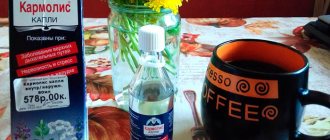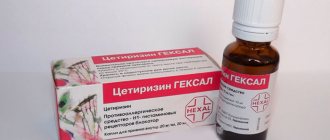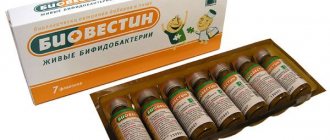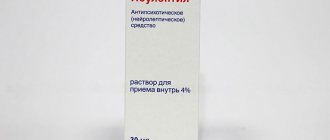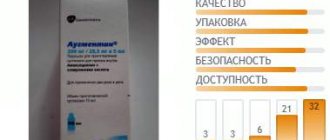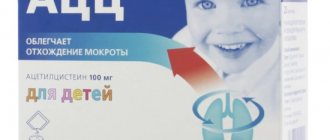Pharmacological properties
Pharmacodynamics
Valocordin-Doxylamine is one of the H1-histamine receptor blockers from the ethanolamine group. It has a sedative, hypnotic, m-anticholinergic and antihistamine effect.
Thanks to taking the drug, the time to fall asleep is reduced, the quality and duration of sleep increases, while the sleep phases do not change.
The effect of the drug Valocordin-Doxylamine develops within 30 minutes after oral administration, its duration is 3-6 hours.
Pharmacokinetics
Doxylamine is almost completely and quickly absorbed. The maximum concentration in the blood serum is detected 2–2.4 hours after taking a single dose (25 mg of doxylamine succinate) and is 99 ng/ml.
Metabolism occurs primarily in the liver. Main metabolites: N-desmethyl doxylamine; N,N-didesmethyl doxylamine and their N-acetyl conjugates. It penetrates well through histohematic barriers, including the blood-brain barrier.
The half-life ranges from 10.1 to 12 hours. Approximately 60% of the dose is excreted unchanged in the urine, and partly through the intestines.
general information
Volocordin-Doxylamine - a histamine H1 receptor blocker belongs to the group of ethanolamines. Acts on the body as a sleeping pill, sedative. Has antiallergic effects, m-anticholinergic dynamism. In terms of the sedative effect, the medicine is comparable to barbiturates.
Composition and mechanism of action
Valocordin-Doxylamine in 1 ml of its composition has: doxylamine succinate - the active component, as auxiliary components - ethanol, peppermint oil, purified water.
Doxylamine succinate belongs to the group of antihistamines with pronounced sedative properties. H1 receptor antagonists have a calming effect on the human body. By blocking H1 receptors, doxylamine reduces the effects of endogenous histamine and has a depressant effect on the central nervous system.
Because of its sedative effects on the body, doxylamine succinate is used for short-term treatment of sleep disorders. Numerous H1 receptor antagonists have the inhibitory effect of acetylcholine on muscarinic receptors. The anticholinergic characteristics of doxylamine are negligible.
Prices and form
The drug is produced in the form of a clear, colorless solution with a pleasant odor. Intended for internal consumption. The cost of Valocordin-Doxylamine varies depending on the volume of the bottle and the pricing policy of a particular pharmacy chain. Average prices in Russia and Ukraine are presented in the table (Table 1).
Table 1 – Cost of Valocordin-Doxylamine
| Volume, ml. | Russia price, rub. | Ukraine price, UAH. |
| 20 | 118-170 | 52-65 |
| 50 | 230-258 | 105-117 |
Contraindications
Absolute:
- prostatic hyperplasia, occurring with disturbances in the outflow of urine;
- acute asthmatic attack;
- bronchial asthma or other respiratory diseases that are characterized by increased sensitivity of the respiratory tract (which is associated with mint oil included in the drug);
- angle-closure glaucoma;
- pheochromocytoma;
- congenital long QT syndrome;
- epilepsy;
- poisoning with alcohol, tranquilizers, neuroleptics, antidepressants, lithium preparations, drugs with sleeping pills, narcotic and analgesic effects in the acute course;
- combined use with monoamine oxidase inhibitors;
- age under 18 years;
- breastfeeding period;
- individual intolerance to the components of the drug, as well as other antihistamines.
Relative (diseases/conditions in the presence of which the use of the drug Valocordin-Doxylamine requires caution):
- gastroesophageal reflux;
- liver and heart failure;
- alcoholism;
- indications in the anamnesis of bronchospasm;
- arterial hypertension;
- local damage to the cerebral cortex and a history of seizures (therapy requires special caution, since Valocordin-Doxylamine, even in small doses, can cause severe attacks of epilepsy; an EEG is recommended; anticonvulsant therapy should not be interrupted);
- chronic shortness of breath;
- achalasia cardia;
- pyloric stenosis;
- age over 65 years;
- pregnancy.
Indications for use
Valocordin-Doxylamine is used in persons over 18 years of age for the symptomatic treatment of recurrent sleep disorders, including frequent awakenings at night and difficulty falling asleep.
It is worth noting that not all sleep disorders require drug treatment. Sleep disturbances are often caused by mental illness or deteriorating health conditions. In these cases, they can be eliminated by direct treatment of the underlying disease or other non-drug methods. Therefore, it is not recommended to treat chronic sleep disorders with Valocordin-Doxylamine for a long time and without consulting a doctor.
Instructions for use of Valocordin-Doxylamine: method and dosage
Valocordin-Doxylamine is taken 30–60 minutes before the desired time of sleep, orally with 100–150 ml of liquid (water).
Unless otherwise prescribed by a doctor, the single dose is 22 drops (1 ml). In cases of insufficient effectiveness, the dose can be increased by 2 times (maximum).
To avoid disturbances in psychomotor reactions upon awakening, it is necessary to ensure sufficient sleep duration.
In case of acute sleep disorders, if possible, it is recommended to limit the use of the drug Valocordin-Doxylamine to a single dose. To check the need to continue therapy for regular sleep disturbances, no later than 14 days from the start of daily use, proceed to a gradual reduction in the dose.
The duration of use is usually 2–5 days, the maximum course duration is 14 days.
For patients with a possible increased susceptibility to the action of the drug (old age, renal or liver failure), Valocordin-Doxylamine is recommended to be taken in reduced doses.
Analogs
There are no exact analogues of the drug, but the following drugs are similar to it in terms of the active component:
Reslip. A drug based on doxylamine succinate, intended for the treatment of all forms of sleep disorders. Available in tablet form. In addition to sleeping pills, it has an antihistamine and sedative effect. It is taken by children over 15 years of age, dosage – a tablet half an hour before bedtime. The price of the drug is 250-300 rubles.- Donormil. It has the same active ingredient, similar indications and contraindications. Taken exclusively for sleep disorders. Available in tablet form. Can be taken from 15 years of age. The cost is slightly higher - 300-550 rubles.
Also, to relieve mild forms of sleep disorders, non-special preparations in the form of drops based on other components can be used, such as:
- Corvaldin is a sedative drug. The use of the medicine is prescribed for functional disorders of the cardiovascular system (for example, sinus tachycardia, cardialgia), insomnia, neuroses based on increased anxiety, fear, irritability, and excessive excitability with pronounced vegetative reactions.
The drug is produced in the form of colorless drops with a specific odor. Take this medicine before meals, dissolving it in a small volume of water. The dosage and duration of use is determined by the attending physician.The dosage is 15 to 20 drops 3 times a day. The maximum dose of one-time use can reach up to 30 drops in severe cases of sleep disturbance. The average cost of one bottle of Corvaldin is 77 rubles.
- Corvalol belongs to the group of hypnotics and sedatives with a subtle antispasmodic effect. This remedy is used for insomnia and to relieve various neuroses. The drug affects the entire body, has a positive effect on heart tone and helps reduce muscle spasms.
This medicine is available in the form of solution and tablets. Before use, dissolve 15-30 drops of the medicine in a small amount of water (30-50 ml). Take before meals up to three times a day. The maximum single dosage, as needed, can reach 40-50 drops.
For children, the dosage varies (3-15 drops per day) depending on the severity of the disease. The price of the drug in the form of drops starts from 25 rubles (for 25 ml) to 39 rubles (for 50 ml). Corvalol tablets can be purchased at a price of 22 rubles for 1 blister (10 tablets).
Valocordin acts as a sedative, antispasmodic, and promotes easier sleep. Prescribed as a vasodilator and sedative. Indications for use are: insomnia, cardialgia, arterial hypertension in the early stages, hypochondriacal syndrome, sinus tachycardia, autonomic lability, irritability, neurotic conditions.As an antispasmodic medicine, the drug is effective against spasms in the gastrointestinal tract of the muscular organs. It is produced in the form of colorless drops with a specific odor in dark glass bottles. Apply Valocardin 10-20 drops 3 times a day on the recommendation of a doctor. The drops dissolve in a small amount of water.
In cases of attacks of tachycardia or angina pectoris, the dose of single use can be increased to 30-40 drops. It is not recommended to set the therapeutic course longer than 10-14 days. For adolescents over 14 years of age, the permissible single dose should be no more than 3-5 drops up to three times a day. The cost of a 20 ml bottle ranges from 127 to 140 rubles, 50 ml - from 250 to 280 rubles.
Side effects
Possible adverse reactions (> 10% - very common; > 1% and < 10% - often; > 0.1% and < 1% - uncommon; > 0.01% and < 0.1% - rare; < 0. 01% – very rarely; with an unknown frequency – if it is impossible to estimate the frequency of development of disorders from the available data):
- psyche: decreased concentration and speed of psychomotor reactions, depression, paradoxical reactions (in the form of restlessness, agitation, anxiety, insomnia, nightmares, confusion, hallucinations, tremor); with abrupt withdrawal after long-term daily use - rebound insomnia;
- lymphatic system/blood: in exceptional cases – leukopenia, thrombocytopenia, hemolytic anemia; very rarely - aplastic anemia and agranulocytosis;
- endocrine system: with pheochromocytoma - increased release of catecholamines;
- cardiovascular system: arrhythmia, tachycardia, decompensated heart failure, increased or decreased blood pressure; possible – changes on the ECG;
- nervous system: drowsiness, dizziness, headache; rarely – convulsions;
- organ of vision/hearing: accommodation disturbances, increased intraocular pressure, tinnitus;
- digestive system: autonomous adverse reactions, including constipation and dry mouth, possible nausea, diarrhea, vomiting, epigastric pain, increased or decreased appetite; very rarely - paralytic intestinal obstruction (life-threatening);
- respiratory organs: bronchial obstruction, thickening of bronchial secretions, bronchospasm (can cause pulmonary dysfunction);
- musculoskeletal system: muscle weakness;
- biliary tract and liver: liver function disorders (cholestatic jaundice);
- subcutaneous tissue, skin: photosensitivity, allergic skin reactions, impaired thermoregulation;
- kidneys, urinary tract: urinary disorders;
- others: fatigue, nasal congestion, lethargy, relapse of insomnia (a gradual dose reduction is recommended); anterograde amnesia (especially during the first hour after taking it; the likelihood of its occurrence is dose-dependent, the risk is reduced by continuous, long-term sleep), physical/mental dependence (the likelihood increases with increasing duration of treatment/dose, as well as against the background of drug and alcohol dependence , including indications in the anamnesis).
The frequency and severity of adverse reactions can be reduced by careful individual selection of the daily dose. Elderly patients are more likely to experience adverse reactions and, as a result, have a higher risk of falls.
With regular use, the effectiveness of Valocordin-Doxylamine may decrease (addiction).
Overdose
Main symptoms: hallucinations, convulsions, dilated pupils, daytime drowsiness, accommodation paresis, dry mouth, increased body temperature, disturbance of consciousness, redness of the skin of the neck or face, impaired coordination of movements, sinus tachycardia, decreased mood, increased anxiety, involuntary movements, tremor, coma.
In some cases, involuntary movements are warning signs of seizures, which may be evidence of severe poisoning. Even in cases where there are no seizures, poisoning with Valocordin-Doxylamine can lead to rhabdomyolysis, which often occurs with severe renal failure (standard therapy with constant monitoring of creatine phosphokinase activity is indicated).
There is evidence of the development of acute pancreatitis and acute renal failure after taking 500 mg of doxylamine in the treatment of persistent insomnia.
In case of overdose, symptomatic (including m-cholinomimetics and drugs with anticonvulsant action) and supportive therapy (including artificial ventilation) is carried out. Activated carbon is prescribed as a first aid remedy (adults – 50 g, children – 1 g/kg). In cases of taking a large amount of the drug, gastric lavage or induction of vomiting is performed. The use of analeptics is contraindicated, as this can lead to the development of convulsive syndrome. In case of arterial hypotension, due to the possibility of a paradoxical increase in the severity of hypotension, alpha and beta adrenergic stimulants, including epinephrine (adrenaline), are not prescribed (the use of norepinephrine is advisable).
Drugs with beta-adrenergic stimulating effects should be avoided as their use may lead to increased vasodilation. In case of severe poisoning (loss of consciousness, cardiac arrhythmia) or the appearance of anticholinergic syndrome (with ECG monitoring), an antidote can be prescribed - physostigmine salicylate. For repeated epileptic seizures, drugs with anticonvulsant action are indicated. Due to the increased likelihood of respiratory depression, their use is possible only in cases where artificial ventilation is possible.
The effectiveness of forced diuresis in doxylamine overdose has not been established; hemodialysis, peritoneal dialysis and hemofiltration have not been studied, however, due to the large volume of distribution of the active substance, these methods are unlikely to be effective.
Who is the remedy indicated for?
Instructions for use of the medicine include the following indications:
- periodic sleep disorders;
- rashes on the body of an allergic nature;
- skin itching;
- other allergic reactions;
- as an auxiliary medication in the treatment of cough and other manifestations of viral diseases.
The main indication for the use of the drug is insomnia.
Despite the rather harmless composition of the drug, it is recommended to take it strictly as prescribed by a doctor, since the drug has a large number of contraindications.
special instructions
The drug Valocordin-Doxylamine contains ethanol, which can be dangerous in the presence of liver disease, alcoholism, epilepsy, as well as for pregnant women.
During therapy, regular monitoring of cardiac function is required, since there are reports of ECG changes, in particular, changes in the repolarization phase (this should be taken into account in particular in elderly patients and patients with heart failure).
Valocordin-Doxylamine can aggravate the course of sleep apnea syndrome (in the form of an increase in the number and duration of attacks of sudden respiratory arrest during sleep).
Impact on the ability to drive vehicles and complex mechanisms
When driving vehicles, it is necessary to take into account the likelihood of a negative effect of Valocordin-Doxylamine on the ability to actively participate in road traffic, especially in cases of combined use with alcohol. In this regard, it is recommended to avoid driving a car (at least during the first phase of therapy). In each specific case, the decision must be made by a doctor.
Reviews from experts
On the Internet you can find a lot of reviews from doctors about the drug Valocordin-Doxylamine. Most of them are positive. Some of them are offered for review:
Cardiologist, O.M. Zubchenko: “Valocordin-Doxylamine is an excellent cure for insomnia. But you should take this medicine without a doctor’s prescription only if you are sure there are no contraindications. Otherwise, the results of self-medication can be very disastrous.”
Cardiologist, I.A. Babenkov: “Quite often I practice prescribing this medicine to patients to restore healthy sleep. But Valocordin-Doxylamine is not recommended to be taken for a long time, as it is addictive. For most cases, a week of use is enough, but only if the patients do not have disorders of the central nervous system or other vital systems.”
Pharmacist, I.D. Danko: “As you know, insomnia is manifested by problems falling asleep, night awakenings, daytime sleepiness, fatigue, etc. The sleeping pill Valocordin-Doxylamine, which is produced by the German pharmaceutical company Krewel Meuselbach GmbH, has already gained popularity on the market in Russia. The product is available in the form of a solution in a bottle with a convenient dispenser, and is affordable.”
Pharmacist, A.N. Nikitina: “Treating insomnia is not an easy procedure. My job is to tell customers about the features of therapy. The drug Valocordin-Doxylamine has great resources for the treatment of sleep disorders.
It is used in the initial stages of pathology, helps normalize sleep without affecting its structure, reduces the time of falling asleep and the number of awakenings. The medicine is produced in a convenient drop form with a dispenser, it begins to act in half an hour, and works for up to 8 hours.”
Drug interactions
Possible interactions:
- baclofen, thalidomide, pizotifen, antidepressants, codeine-containing analgesics, neuroleptics, narcotic analgesics, barbiturates, benzodiazepines, anxiolytics, antitussives and sedatives, other H1-histamine receptor blockers, central antihypertensive drugs (clonidine, alpha-methyldopa): increased inhibitory effect on the central nervous system;
- ethanol, drugs containing ethanol: increased sedative effect of the drug Valocordin-Doxylamine (the combination is recommended to be avoided);
- antiarrhythmic drugs, protease inhibitors, antipsychotics, beta-blockers, immunosuppressants, antiepileptic drugs and other drugs metabolized by the enzymes CYP2, CYP3A and CYP2A: a significant increase in their activity, the possibility of interaction cannot be excluded;
- monoamine oxidase inhibitors: development of arterial hypotension, depression of respiratory function and central nervous system;
- drugs with m-anticholinergic activity (tricyclic antidepressants, atropine and atropine-containing antispasmodics, monoamine oxidase inhibitors, antiparkinsonian drugs, phenothiazine antipsychotics, disopyramide): unpredictable increase and prolongation of the anticholinergic effect of Valocordin-Doxylamine, which increases the likelihood of disorders such as constipation, retention urine, dry mouth, paralytic ileus, increased intraocular pressure;
- photosensitizing drugs: additive photosensitizing effect;
- salicylates, aminoglycosides, diuretics and other ototoxic drugs: masking the initial signs of damage to the inner ear (dizziness, tinnitus, confusion);
- epinephrine (to eliminate arterial hypotension): paradoxical increase in the severity of hypotension; in shock conditions, the use of norepinephrine is indicated.
During therapy, skin test results may be false negative.
